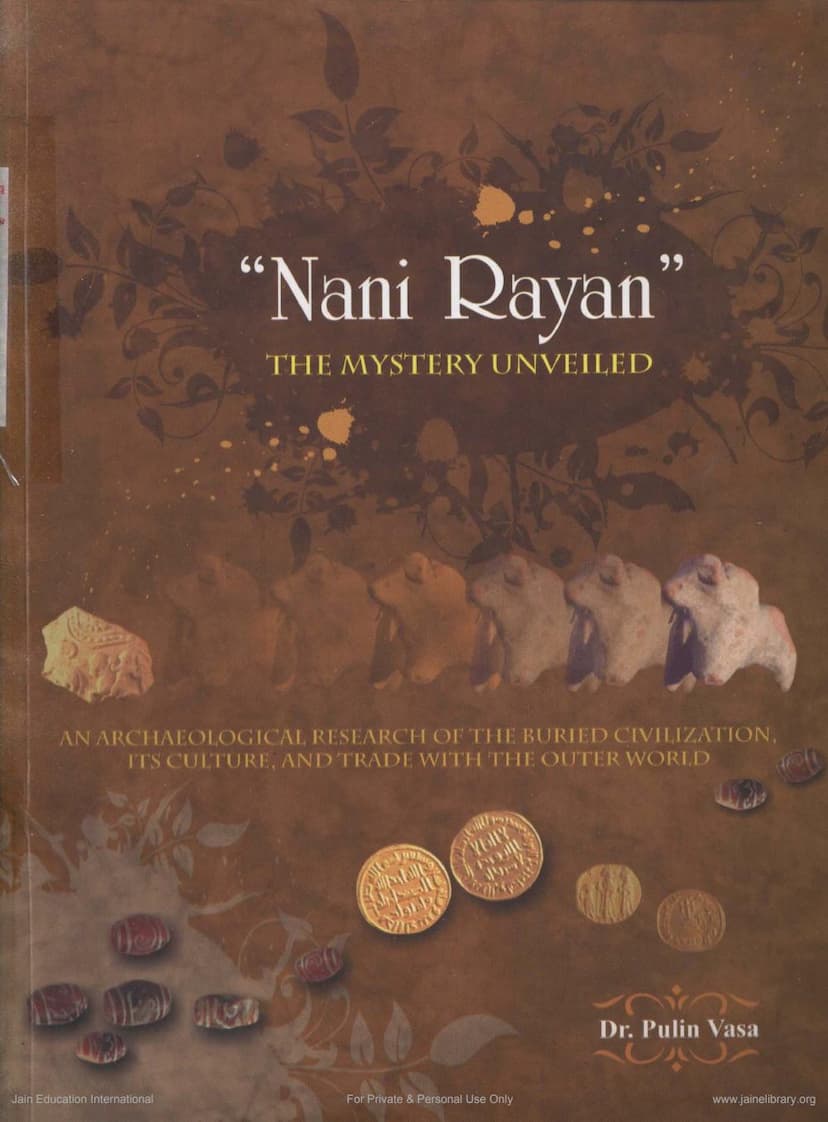Nani Rayan
Added to library: September 2, 2025

Summary
"Nani Rayan: The Mystery Unveiled" by Dr. Pulin Vasa is an archaeological research book that details the exploration and findings of a buried civilization at Nani Rayan, a village in Kutch, Gujarat, India. The book, published by Kalikalsarvajna Shri Hemchandracharya Navam Janmashatabdi Smruti Sanskar Shikshan Nidhi, Ahmedabad, presents the author's extensive research, spanning over 20 years, into this ancient site.
Dr. Vasa, a physician by profession, developed a passion for archaeology and dedicated himself to uncovering the history of Nani Rayan. The book is structured to guide the reader through his discoveries, starting with the geographical and historical context of Kutch, then detailing the specific site of Nani Rayan, its excavated antiquities, and comparative studies with other Indian archaeological sites.
Key aspects and findings highlighted in the book:
- Introduction to Nani Rayan: The author's personal journey of discovery began with stumbling upon Roman amphorae fragments, sparking his curiosity about the site's past. He describes the village's location on the bank of the Rukmavati river, which flows into the Gulf of Kutch, and its potential as a historical river port.
- Geographic and Historic Perspective of Kutch: The book provides a comprehensive overview of Kutch's geological history, its strategic coastal location, and its significance as a maritime center throughout various historical periods, including the Indus Valley Civilization, Kshatrap, Gupta, and Maitrak periods. It discusses the migration of people, trade routes, and cultural influences in the region.
- Description of the Site: Nani Rayan is described as a village sitting atop a buried civilization. The author details his methodology of collecting artifacts, often from surface finds or during agricultural activities. The crucial role of pipeline trenches in revealing cross-sections of the buried site is emphasized, showing evidence of walls, kilns, and skeletal remains.
- Antiquities: A significant portion of the book is dedicated to cataloging and describing the various artifacts unearthed from Nani Rayan. These include:
- Ornaments: Beads made of sandstone, semi-precious stones, shell, and terracotta, as well as shell bangles and ornament-making dyes. The author notes the high quality of craftsmanship, particularly in shell bangle making, with designs like peacocks.
- Pottery: Various types of pottery, including plain red ware, molded ware, stamped ware (often depicting human and animal figures, floral, and geometric patterns), rouletted ware (indicating Roman influence), and Roman amphorae (suggesting trade in wine and olive oil). The discovery of rouletted ware is highlighted as a significant, though surprising, find.
- Coins and Seals: Numerous coins from the Kshatrap, Gupta, Early Medieval Gujarat, and Arab periods are documented. Notably, a Byzantine coin of Heraclius and an Arab Dinara of Baghdad are reported, signifying trade links with Constantinople and Baghdad respectively. Seals with Brahmi inscriptions are also discussed.
- Human Figurines: Terracotta and stone figurines, including mother goddess figures (like Lajja Gauri), a potential Kushan sculpture, and figures possibly representing Shiva and Parvati, are described.
- Toys: Animal figurines, such as bulls and elephants, are mentioned.
- Metal Objects: Bronze prototypes of molded ware, a bronze structure with an elephant, iron slag, net weights, and metal ingots are listed.
- Domestic Objects: Roman grinding stones, rotary querns, mullers, pestle stones, and potter's dabbers are described.
- Comparative Study: Dr. Vasa compares the finds from Nani Rayan with those from other significant archaeological sites in Gujarat (Devnimori, Somnath, Shamalaji, Nagara, Siot) and Maharashtra (Nevasa, Ter, Kondapur, Kolhapur), highlighting similarities in pottery, ornaments, and other artifacts, which point to extensive cultural and trade connections across ancient India.
- Discussion: The author synthesizes his findings to answer key questions about the Nani Rayan civilization: its age (dating back to the Harappan period and flourishing through the early history period to the 10th century AD), the people who inhabited it (likely Indo-Greeks or Shakas, with evidence of Hindu and Buddhist religious practices), their occupations (pottery making, bead making, shell bangle industry, agriculture, fishing), their religious and cultural background, and their extensive trade contacts with the Western world, the Middle East, and other parts of India.
- Trade and Commerce: The book details India's ancient maritime trade, emphasizing the importance of sea routes and the monsoon winds. It discusses imports and exports, with Nani Rayan playing a role as a river port for trade with Rome, Europe, and the Middle East.
- Causes of Burial: Dr. Vasa hypothesizes that the civilization was buried due to silt deposition from the nearby Rukmavati river during floods.
In essence, "Nani Rayan: The Mystery Unveiled" presents a compelling case for Nani Rayan being a significant, though previously overlooked, archaeological site that offers valuable insights into ancient Indian civilization, its craftsmanship, cultural exchanges, and trade networks, particularly its connections with the Western world. The author's meticulous research and accessible writing style bring to light the richness of India's past.